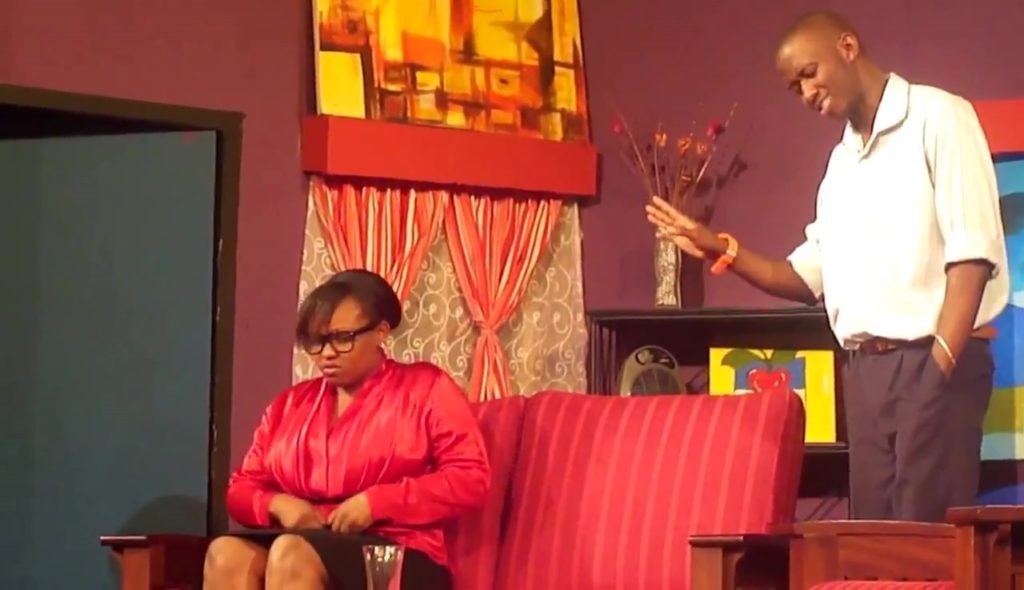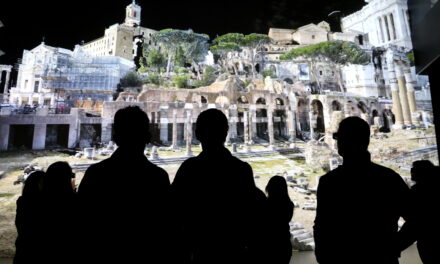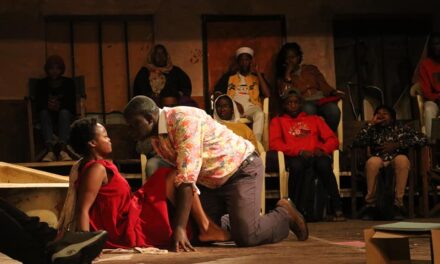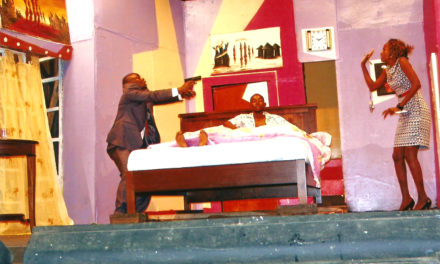Kenya National Theatre (KNT) was initially built as a recreational centre for British soldiers during the colonial era. KNT is now part of the Kenya Cultural Centre, which also includes The Kenya Conservatoire of Music. East African literary titans Wahome Mutahi, Francis Imbuga, John Ruganda, and Ngugi wa Thiong’o have all staged plays there. Ngugi wa Thiong’o’s KNT plays included The Trial of Dedan Kimathi and Ngahiika Ndeenda (‘I Will Marry When I Choose’). Francis Imbuga is probably the best-known Kenyan playwright, with his works including Betrayal in the City, Aminata, Shrine of Tears, Man of Kafira and the Burning of Rags.
Mombasa’s Little Theatre Club was initially a club for Royal Navy sailors after World War II but was later leased out for various functions, including serving as a hospital. In 1952, white settlers leased the space and established The Little Theatre Club for their own entertainment. Performances ranged from stage plays to choreographed dances, and jazz legend Louis Armstrong even performed there in 1960. The Little Theatre has a chequered history. It nearly faded into insignificance in the last decade but, luckily, the government recently designated it a national monument.
Kenya’s sizeable South Asian community is also culturally active, staging numerous Hindi/Gujerati productions that include dance, poetry, music, and acting. In 2017, the Kenyan Indians were officially recognized by the government as “Kenya’s 44th tribe.” Recent “Kenindian” plays include Pehli Preet (“First Love”) and Dhabakta Haiya (“Throbbing Heart”). Stories of a Dead Lake, which was written by Kenyan Steve Ongeri and was staged at Braeburn School in May 2017, follows the travails of a Hindu widow.
Phoenix Theatre was established in 1983 by the fabled James Falkland and was the largest and oldest repertory theatre company in East and Central Africa. Their 120-seat auditorium was located in the Professional Centre on Parliament Road, Nairobi. Phoenix alumni include Ian Mbugua (TV’s “Judge Ian”), TV presenter Jimmi Gathu, radio presenter Edward Kwach, comedian Charles Bukeko (TV’s “Papa Shirandula”), poet Caroline Nderitu, thespian/writer John Sibi-Okumu, TV host Sheila Mwanyiga, thespian Millicent Ogutu, TV presenter Julie Gichuru, former TV presenter Lorna Irungu, actress Lupita Nyong’o (the first indigenous Kenyan to win an Oscar award) and the former Phoenix Theatre GM David Opondoe. Its name symbolized the return of theatrical performances – a rising from the ashes – after the nearby Donovan Maule Theatre (est. 1947) was burnt to the ground.
Popular venues for stage plays include Alliance Française, Goethe Institut, Mageuzi Theatre, GoDown Arts Centre, Sarakasi Dome, Braeburn School, Visa Oshwal School, and the Courtyard Theatre (all in Nairobi City).
THE GOOD
A few theatre groups, like Heartstrings Kenya and Festival of Creative Arts, have found ways of creating critically and commercially successful plays. Heartstrings plays are usually comedies with localized themes and colloquial language. Some of their many hits include Dare Kenyans To Love, News Made in Kenya, Divorce Made in Kenya, Kenyan Playboy, and 50% Kenyan.
On September 4, 2015, President Uhuru Kenyatta officiated the re-opening of the Kenya Cultural Centre. The renovation process took a couple of years and was sponsored to the tune of about Kshs 100 million (US$ 1,1 million) by a local beer company. In his speech, the President said:
“There are those, also, who had to flee our country so that their artistic expression could thrive. Once again, today, it is with pleasure that we welcome two of them: Professor Ngugi wa Thiong’o and Professor Micere Mugo. These artists and many more, are the vanguard of Kenya’s recent artistic resurgence. Both Ngugi and Micere no longer have to live abroad to be the best that they can be.”
The first major production to be staged at the renovated KNT was Puma, which was written and directed by Mkawasi Mcharo. Mkawasi has been involved in stage work for over 20 years and had previously staged Pamabuzaka (1996) and Subira (1997) at KNT.
Many thespians, especially in Nairobi, are increasingly showing interest in high-quality commercial productions, as opposed to high-school-type acting-for-fun arrangements. For example, in 2010, brothers Peter and Paul Oyier of Sterling Entertainment Productions staged the famous South African musical Sarafina! in Kenya with a local cast, and even brought “Sarafina” herself (South African actress Leleti Khumalo) to the premiere.
The Sanaa Theatre Awards were launched in 2013, as Kenya celebrated 50 years of being a republic. Prior to that, Kenya hadn’t had any major awards for professional theatre since 2004, when the Mbalamwezi Awards went under.
THE BAD
If there’s one aspect of Kenyan theatre that drives audiences to distraction, it is the industry’s obsession with foreign plays. Critics have complained about this countless times, but most players seem to turn a deaf ear to the criticism. The constant re-hashing of European bedroom farces (with a few minor changes to the names, places, and locations in order to “localize” the content) conveys a lack of originality. Many of the shows staged to this day were penned by such foreign playwrights as Ray Cooney (Not Now Darling, Run for Your Wife, Husband for Breakfast, Wife Begins at Forty), Marc Carmoletti (Boeing Boeing) and Derek Benfield (Bedside Manners).
The stock answer given to critics when they ask why foreign plays keep being regurgitated is that Kenyan scripts and playwrights can’t match the “quality” of their foreign counterparts, which is a lazy answer that can’t withstand cross-examination. How do you explain the runaway success of Heartstrings Kenya, which specializes in local content? How do explain the rise of vernacular (especially Kikuyu and Dholuo) plays in recent times? How have scriptwriters like John Sibi-Okumu (Minister Karibu, Role Play, Meetings) and Cajetan Boy (All Girls Together, Backlash, Benta) managed to earn positive reviews from critics if their writing is not up to par?
In addition, most Kenyan productions last only one weekend and then are buried for good. All that time and effort spent writing an original script, memorizing, rehearsing, traveling, finding a venue, decorating, and so on is wasted on a short run. There’s no way this model can generate enough to justify multiple future productions. The cast and crew can only do this for the love of theatre – the camaraderie, the thrill of being on stage, the living out of a childhood dream/fantasy, etc. Otherwise, everyone involved had better hang on to their day jobs.
Other “downers” include poor marketing/promotion, and lack of professionalism from some cast members, who sometimes arrive late or treat productions as hobbies rather than jobs.
THE UGLY
Theatre in Kenya has long been considered a “hunger art.” Actors’ remunerations are often pitiable and most thespians act for the love of it, or as a springboard to more profitable acting opportunities in TV, film, or commercials. Quite a number of top TV and celluloid stars cut their teeth in the poverty-stricken theatres. These stars include Charles Bukeko (TV’s “Papa Shirandula”), Daniel Ndambuki (mega star of TV’s “Churchill Live”), Carolyne “Teacher Wanjiku” Ber (comedian), Joni “Ras” Gathui (TV’s “Mother–In-Law”), Peter Marangi (seen on Dura Coat paint ads), Felix Jalang’o (radio/TV comedian), and singer/actor Linet Muraya (better known as “Size 8”). The hit movie Nairobi Half Life, directed by Tosh Gitonga, drew almost all its actors from the world of theatre.
For the most part, however, theatre in Kenya remains a “hunger art.” Due to lack of funds, many thespians rehearse in public places such as Uhuru Park and the Nairobi Arboretum.
Many playhouses have also experienced financial struggles. For decades, Phoenix Theatre was described as living up to its name by nearing extinction several times but magically rising again. On Wednesday, April 19, 2017, however, Phoenix Theatre finally closed shop. Breaking the news via a series of Twitter posts, actor/director Mugambi Nthiga said:
“Phoenix was located in a rented space at The Professional Centre. Rent had to be paid and theatre makes money from tickets & sponsorships only. @thephoenixkenya has struggled for several years. It thrived on membership in better years…
Today, while a benefit staging of a play was being planned to help raise funds for the theatre, auctioneers showed up and took everything.’”
This post was written by the author in their personal capacity.The opinions expressed in this article are the author’s own and do not reflect the view of The Theatre Times, their staff or collaborators.
This post was written by Alexander Nderitu.
The views expressed here belong to the author and do not necessarily reflect our views and opinions.


















